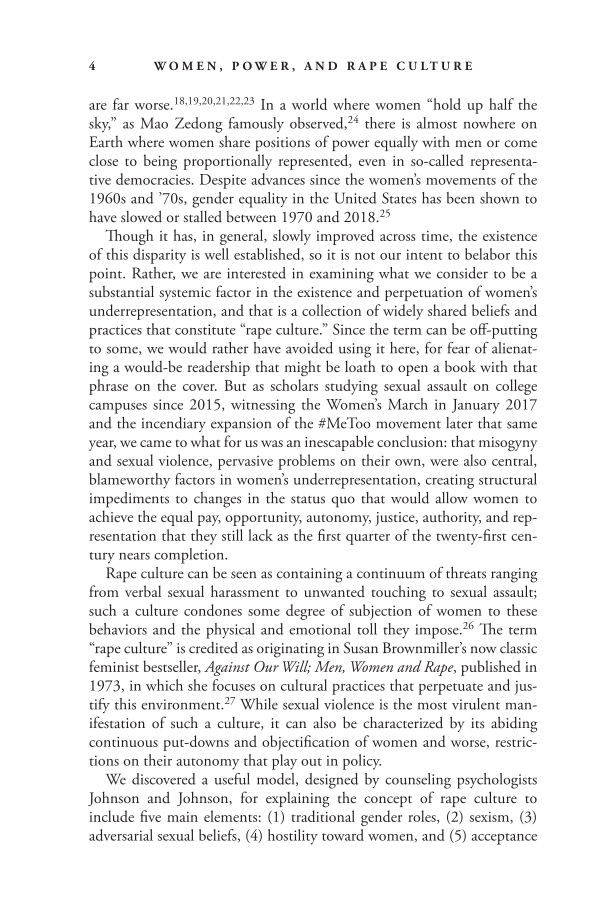W O M E N , P O W E R , A N D R A P E C U L T U R E 4 are far worse.18,19,20,21,22,23 In a world where women “hold up half the sky,” as Mao Zedong famously observed,24 there is almost nowhere on Earth where women share positions of power equally with men or come close to being proportionally represented, even in so-called representa- tive democracies. Despite advances since the women’s movements of the 1960s and ’70s, gender equality in the United States has been shown to have slowed or stalled between 1970 and 2018.25 Though it has, in general, slowly improved across time, the existence of this disparity is well established, so it is not our intent to belabor this point. Rather, we are interested in examining what we consider to be a substantial systemic factor in the existence and perpetuation of women’s underrepresentation, and that is a collection of widely shared beliefs and practices that constitute “rape culture.” Since the term can be off-putting to some, we would rather have avoided using it here, for fear of alienat- ing a would-be readership that might be loath to open a book with that phrase on the cover. But as scholars studying sexual assault on college campuses since 2015, witnessing the Women’s March in January 2017 and the incendiary expansion of the #MeToo movement later that same year, we came to what for us was an inescapable conclusion: that misogyny and sexual violence, pervasive problems on their own, were also central, blameworthy factors in women’s underrepresentation, creating structural impediments to changes in the status quo that would allow women to achieve the equal pay, opportunity, autonomy, justice, authority, and rep- resentation that they still lack as the first quarter of the twenty-first cen- tury nears completion. Rape culture can be seen as containing a continuum of threats ranging from verbal sexual harassment to unwanted touching to sexual assault such a culture condones some degree of subjection of women to these behaviors and the physical and emotional toll they impose.26 The term “rape culture” is credited as originating in Susan Brownmiller’s now classic feminist bestseller, Against Our Will Men, Women and Rape, published in 1973, in which she focuses on cultural practices that perpetuate and jus- tify this environment.27 While sexual violence is the most virulent man- ifestation of such a culture, it can also be characterized by its abiding continuous put-downs and objectification of women and worse, restric- tions on their autonomy that play out in policy. We discovered a useful model, designed by counseling psychologists Johnson and Johnson, for explaining the concept of rape culture to include five main elements: (1) traditional gender roles, (2) sexism, (3) adversarial sexual beliefs, (4) hostility toward women, and (5) acceptance
Document Details My Account Print multiple pages
Print
You have printed 0 times in the last 24 hours.
Your print count will reset on at .
You may print 0 more time(s) before then.
You may print a maximum of 0 pages at a time.









































































































































































































































